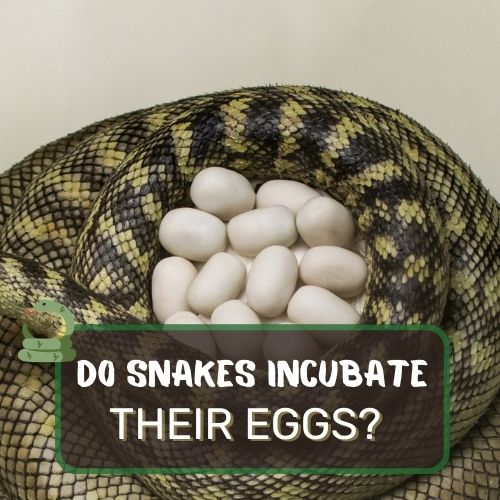
In this article, we will explore the intriguing question, “Do snakes incubate their eggs?”
We’ll delve into the diverse world of snake reproduction, examining the various strategies these fascinating creatures employ to ensure the successful development of their offspring.
Discover the different species that practice maternal incubation, the factors influencing incubation periods, and the benefits of artificial incubation.
From the intricacies of hatching to the post-hatching care of snake hatchlings, readers will gain insights into the captivating process of snake egg incubation and the importance of conservation efforts in preserving these remarkable reptiles.
Table of Contents
- 1 Do Snakes Incubate Their Eggs: Short Answer?
- 2 Snake Egg Incubation Process
- 3 Snakes that Incubate their Eggs
- 4 Incubation Period of Snake Eggs
- 5 Natural Incubation vs. Artificial Incubation
- 6 Caring for Snake Eggs during Incubation
- 7 Signs of Healthy Development in Snake Eggs
- 8 Troubleshooting Incubation Issues
- 9 Hatching of Snake Eggs
- 10 Post-Hatching Care for Snake Hatchlings
- 11 FAQ
- 12 Conclusion
Do Snakes Incubate Their Eggs: Short Answer?
Yes, snakes incubate their eggs. However, the incubation process varies among different snake species and can be influenced by various environmental factors. Snake reproduction is fascinatingly diverse, with some species giving live birth (viviparous) and others laying eggs (oviparous).
Oviparous snakes, the ones that lay eggs, have evolved different strategies for incubating their eggs. One of the most well-known methods is maternal incubation, where the female snake provides care and warmth to her clutch.
Maternal incubation is predominantly observed in certain snake families and species that have developed this unique behavior over time.
During maternal incubation, the female snake coils her body around the clutch of eggs, providing warmth and stability to create an optimal environment for embryonic development.
By wrapping around the eggs, the mother ensures a consistent and suitable temperature, vital for the successful development of the embryos.
This behavior is especially important for maintaining consistent conditions in unpredictable or fluctuating environments.
Snake Egg Incubation Process

Snake reproduction is a fascinating and diverse field in the animal kingdom. Unlike mammals and birds, many snake species are oviparous, meaning they lay eggs to reproduce.
The incubation process of these snake eggs plays a crucial role in determining the survival and development of the snake offspring.
Let’s delve into the captivating world of snake egg incubation and explore the different factors that influence this process.
Different Snake Species That Lays Eggs
When it comes to snake reproduction, there’s a significant variation among species. While some snakes give live birth (viviparous), others lay eggs (oviparous). For the purpose of this discussion, we’ll focus on oviparous snakes.
Oviparous snakes are found across the globe, from tropical rainforests to arid deserts. These species exhibit diverse nesting behaviors and egg-laying strategies.
Some snakes, like the ball python (Python regius), construct nests by coiling around their eggs and providing a safe, warm environment for incubation.
On the other hand, others like the hognose snake (Heterodon spp.) may merely lay their eggs in preexisting holes or burrows.
The diversity doesn’t stop there; even within the same species, there can be variations in the way eggs are laid and incubated.
For example, certain populations of the same snake species might choose different nesting sites or incubation methods based on their environment and available resources.
Factors Affecting Snake Egg Incubation
Snake egg incubation is a delicate process influenced by various factors that snakes have evolved to cope with.
1. Temperature
Temperature plays a pivotal role in the incubation process of snake eggs. Unlike mammals, snakes are ectothermic, meaning their body temperature is regulated by external factors.
The temperature at which the eggs are incubated determines the rate of embryonic development and ultimately influences the sex of the offspring in some species through temperature-dependent sex determination (TSD).
In species with TSD, specific temperature ranges lead to the development of either male or female offspring.
For example, in some sea turtle species, higher incubation temperatures tend to produce more female hatchlings, while cooler temperatures favor male hatchlings.
Similarly, certain snake species may follow this pattern, impacting the gender balance within their populations.
2. Humidity
Humidity is another critical factor in snake egg incubation. Proper humidity levels within the nest are essential to prevent the eggs from drying out.
In regions with arid climates, snakes may adapt their nesting behaviors to retain moisture and ensure successful incubation.
A balance between temperature and humidity is crucial for optimal egg development. Extreme conditions, either too hot or too dry, can lead to unsuccessful incubation and low hatchling survival rates.
3. Nesting Sites
The choice of nesting sites can significantly impact the outcome of snake egg incubation. Some species prefer warm, sunny spots, while others may seek out cooler, shaded areas.
The type of nesting site chosen by a snake can influence the temperature and humidity levels experienced by the eggs.
Natural predators and environmental threats are also taken into account when selecting nesting sites. Snakes often opt for concealed or secluded locations to protect their eggs from potential dangers.
Snakes that Incubate their Eggs

Some snake species take parental care to a whole new level by actively incubating their eggs.
Maternal incubation is a fascinating behavior observed in certain snakes where the mother coils around her clutch, providing a warm and safe environment for the developing embryos.
This unique parenting strategy has numerous advantages, benefiting both the mother and the offspring.
Species that Coil Around their Eggs for Incubation
Maternal incubation is predominantly seen in several snake families across different regions. These devoted snake mothers demonstrate remarkable dedication in ensuring the successful hatching of their eggs.
1. Examples of Snakes that Exhibit this Behavior
i. The Ball Python (Python regius): Found in the savannas and grasslands of West and Central Africa, the ball python is renowned for its exceptional maternal incubation behavior. After laying her clutch, the female ball python coils herself around the eggs, forming a protective ball. This posture not only maintains a consistent temperature for the eggs but also shields them from potential threats.
ii. The King Cobra (Ophiophagus hannah): The king cobra, the largest venomous snake in the world, is also known for its maternal instincts. The female king cobra constructs a nest using leaves and vegetation and lays her eggs inside. She then remains coiled around the nest, maintaining an optimal temperature and protecting the eggs from predators until they hatch.
iii. The Green Anaconda (Eunectes murinus): As one of the heaviest snakes in the world, the female green anaconda showcases remarkable maternal care. After laying her eggs in a carefully constructed nest, she remains coiled around them throughout the incubation period. Her body heat helps regulate the nest’s temperature, ensuring the embryos develop correctly.
Advantages of Maternal Incubation
1. Increased Survival Rate for the Eggs
Maternal incubation significantly enhances the survival chances of snake eggs. By coiling around the clutch, the mother snake provides a stable microenvironment for the developing embryos.
The close proximity to the mother’s body heat ensures that the eggs remain at the optimal temperature, vital for proper embryonic development.
This nurturing environment minimizes the risk of temperature fluctuations that could otherwise be detrimental to the developing embryos.
Furthermore, the mother’s presence acts as a protective shield against potential threats. Her physical presence deters predators from approaching the eggs, reducing the likelihood of predation during the incubation period.
In contrast, eggs left unattended may fall victim to scavengers or other predators, leading to a decrease in hatching success.
2. Protection from Predators
Maternal incubation provides a unique advantage by offering protection to the vulnerable eggs. Snakes that coil around their clutches deter predators through various means.
Some snake species may hiss, strike, or use their intimidating appearance to fend off potential threats.
Additionally, the mother’s body serves as a physical barrier, making it challenging for predators to access the eggs hidden within the protective coil.
The combination of concealment, intimidation, and defensive behavior significantly improves the survival chances of the eggs during the incubation period.
This behavior is a remarkable adaptation developed over time to ensure the continuity of the species in the face of various environmental challenges.
Maternal incubation in snakes exemplifies the wonders of the natural world, showcasing the diverse and complex strategies adopted by different species to safeguard their offspring.
By understanding and appreciating these behaviors, we gain valuable insights into the intricacies of snake reproduction and the delicate balance of life in the animal kingdom.
Incubation Period of Snake Eggs

The incubation period of snake eggs is a crucial stage in the development of these reptilian embryos.
The duration of incubation can vary significantly across different snake species and is influenced by various factors. Let’s explore the average duration of incubation and the key elements that influence this critical phase.
Average Duration of Incubation
The incubation period of snake eggs is generally species-specific and can range from weeks to several months.
On average, most snake eggs take around 40 to 60 days to hatch, but this can vary widely depending on the snake species and environmental conditions.
For example, some smaller snake species may have a shorter incubation period, while larger species may take longer to complete their development.
Factors Influencing Incubation Period
1. Temperature Variations
Temperature is a primary factor that affects the incubation period of snake eggs. As mentioned earlier, snake reproduction relies on external environmental factors to regulate body temperature.
The ambient temperature during incubation plays a crucial role in determining the rate of embryonic development. Warmer temperatures generally lead to faster development, while cooler temperatures slow down the process.
In some cases, temperature fluctuations can lead to extended or irregular incubation periods.
This variability in the incubation duration can influence the synchronization of hatching, potentially affecting the survival of hatchlings.
2. Species-Specific Differences
Different snake species have evolved to thrive in diverse environments, leading to variations in their reproductive strategies. Consequently, the incubation period can vary significantly from one species to another.
For instance, the smaller and more rapidly developing species may have shorter incubation periods, allowing them to quickly produce offspring in environments with unpredictable conditions.
On the other hand, larger species with longer incubation periods might invest more energy into each clutch and adopt a slower reproductive pace.
Understanding the species-specific differences in the incubation period is crucial for conservation efforts and captive breeding programs aimed at preserving endangered snake species.
Natural Incubation vs. Artificial Incubation

Incubation plays a pivotal role in the successful hatching of snake eggs. In the wild, female snakes exhibit maternal care, coiling around their clutches to provide natural incubation.
However, in captive breeding scenarios or conservation efforts, artificial incubation becomes a valuable technique.
Let’s compare the pros and cons of natural incubation and artificial incubation, along with the techniques and equipment used for the latter.
Pros and Cons of Natural Incubation
Pros:
- Natural Adaptation: Natural incubation allows the embryos to develop under conditions that the species has adapted to over generations, increasing the likelihood of successful hatching.
- Maternal Care: The mother provides protection and regulation of the nest, creating a stable microenvironment for the eggs.
- Low-Tech Approach: Natural incubation requires minimal intervention and equipment, making it an accessible option in the wild.
Cons:
- Predation Risk: Eggs left unattended are vulnerable to predation by scavengers and other animals, leading to potential losses.
- Environmental Limitations: Natural incubation is subject to fluctuations in environmental conditions, which may impact the success rate of hatching.
Techniques and Equipment Used for Artificial Incubation
1. Incubators
Artificial incubation involves the use of incubators, specialized equipment designed to mimic the conditions required for successful embryonic development.
Incubators can control temperature, humidity, and ventilation, providing a stable environment for the eggs.
2. Temperature and Humidity Control
Maintaining precise temperature and humidity levels is crucial for artificial incubation. Temperature control ensures that embryos develop at the optimal rate, while humidity prevents the eggs from drying out.
By carefully monitoring and adjusting these parameters, artificial incubation can offer a controlled environment that maximizes hatching success.
The choice between natural and artificial incubation depends on various factors, including the species being bred, conservation goals, and available resources.
Both approaches play essential roles in preserving snake populations and enhancing our understanding of snake reproduction.
Caring for Snake Eggs during Incubation

The incubation period is a critical time for the development of snake eggs, whether through natural or artificial incubation.
Proper care during this phase is essential to ensure the successful hatching of healthy snake hatchlings. Let’s explore the best practices for caring for snake eggs during incubation.
Handling and Moving Snake Eggs
When it comes to handling snake eggs, a delicate touch is crucial. Excessive movement or rough handling can damage the eggs and disrupt the embryos’ development.
In natural incubation, it’s best to minimize disturbances and avoid handling the eggs unless necessary.
In artificial incubation, where eggs may need to be moved to incubators, it’s essential to be gentle and avoid sudden jolts or impacts.
Special care should be taken to ensure that the orientation of the eggs is maintained, as turning them regularly aids in even heat distribution.
Monitoring Temperature and Humidity Levels
Maintaining optimal temperature and humidity levels is a top priority during the incubation period. In natural incubation, the mother snake does an excellent job of regulating these factors.
However, in artificial incubation, it falls to the caretaker to ensure the right conditions.
Regularly monitoring temperature and humidity levels inside the incubator is vital. Temperature fluctuations can impact the rate of development or even lead to developmental abnormalities.
Similarly, improper humidity levels can cause the eggs to dry out or become too moist, increasing the risk of fungal and bacterial growth.
Preventing Mold and Bacterial Growth
In both natural and artificial incubation, preventing mold and bacterial growth is crucial. Mold and bacteria can be harmful to the developing embryos and may lead to egg spoilage.
Maintaining proper humidity levels and providing adequate ventilation in the incubation environment can help reduce the risk of mold and bacterial growth.
Regularly inspecting the eggs for signs of mold and removing any contaminated or damaged eggs can also help maintain a healthy incubation environment.
Signs of Healthy Development in Snake Eggs

Observing and identifying signs of healthy development in snake eggs is essential during the incubation process.
Recognizing these signs can indicate the progress of embryonic development and provide valuable insights into the overall health of the eggs.
Visual Changes in the Eggs
As the embryos develop, the appearance of the eggs may change. The eggs may become more translucent or show slight changes in coloration.
However, these changes can vary significantly among different snake species, so it’s essential to be familiar with the specific characteristics of the eggs for accurate assessment.
Observing Movement or Hatching Activity
As the incubation period progresses, some eggs may show signs of movement or hatching activity. This can include slight vibrations or rocking motions within the egg, indicating that the hatchling is preparing to emerge.
Patience is essential during this stage, as hatching can be a lengthy process that varies depending on the species.
It’s important to resist the urge to assist the hatchlings during hatching, as they need to complete the process on their own. Prematurely assisting them may lead to complications or hinder their ability to survive outside the egg.
By adhering to proper care practices and closely monitoring the eggs, caretakers can increase the chances of successful hatching and contribute to the preservation of snake populations.
Troubleshooting Incubation Issues
While snake egg incubation can be a rewarding experience, caretakers may encounter various challenges that require prompt attention. Understanding common problems and implementing suitable solutions can significantly increase the likelihood of successful hatching.
Common Problems During Snake Egg Incubation
1. Infertile Eggs
One of the most common issues encountered during snake egg incubation is finding infertile eggs. Infertile eggs do not contain viable embryos and will not hatch.
They are often recognizable by their appearance, which may differ from fertile eggs.
2. Stuck or Malpositioned Embryos
Sometimes, embryos may become stuck to the eggshell or adopt a malpositioned posture within the egg. This can hinder hatching or lead to developmental issues if left unaddressed.
Potential Solutions and Interventions
– Egg Candling: Candling involves shining a light through the eggshell to examine the internal contents. Candling can help identify infertile eggs, as they will not show signs of developing embryos.
Removing infertile eggs from the incubation process can prevent potential contamination and conserve resources.
– Assisting Stuck Embryos: If embryos are found to be stuck or malpositioned, caretakers can gently intervene to assist them. It’s crucial to be cautious and seek advice from experienced reptile specialists before attempting any intervention.
Proper techniques and a delicate touch are necessary to avoid causing harm to the embryos.
Hatching of Snake Eggs

The hatching of snake eggs is an exciting and crucial moment in the incubation process. As caretakers eagerly await the arrival of the hatchlings, several signs indicate that hatching is imminent.
Signs of Imminent Hatching
Before hatching, snake embryos may become more active inside the egg, resulting in increased movement or twitching. The eggs may also appear to change in appearance as the hatchling inside positions itself for emergence.
Another sign of imminent hatching is the appearance of a “pip” or small crack in the eggshell. This indicates that the hatchling is using its egg tooth to create an opening through which it will eventually emerge.
Assisting Hatching if Necessary
In most cases, it is essential to allow hatchlings to complete the hatching process independently. However, some situations may arise where intervention becomes necessary for the well-being of the hatchling.
1. Techniques for Aiding Hatchlings
- Moisture Assistance: Providing a slightly humid environment can help soften the eggshell and aid hatchlings in breaking free. This technique is often used when hatchlings are struggling to pip or emerge from the egg.
- Eggshell Removal: If a hatchling is unable to break through the eggshell despite pipping, removing a small portion of the shell can assist the hatchling in completing the process. Extreme care must be taken to avoid injuring the hatchling during this delicate procedure.
Caretakers should exercise extreme caution and seek advice from experienced reptile breeders or veterinarians before attempting any intervention during hatching.
While assisting may sometimes be necessary, it should always be a last resort, as natural hatching is the preferred method for the health and development of the hatchlings.
By proactively addressing incubation issues and closely monitoring the hatching process, caretakers can ensure the best possible outcomes for snake eggs and contribute to the conservation of these remarkable reptiles.
Post-Hatching Care for Snake Hatchlings

After the long incubation period, the arrival of snake hatchlings is an exciting moment. However, their journey has only just begun, and proper post-hatching care is essential to ensure their well-being and healthy development.
Creating an Appropriate Enclosure
The first step in post-hatching care is to provide a suitable enclosure for the snake hatchlings.
The enclosure should mimic their natural habitat as closely as possible, offering appropriate temperature gradients, hiding spots, and substrate.
Depending on the species, some hatchlings may prefer arboreal (tree-dwelling) environments, while others may favor terrestrial setups.
Researching the specific requirements of the snake species is crucial in providing the ideal enclosure.
Feeding and Hydration Requirements for Hatchlings
Feeding hatchlings the right diet is crucial for their growth and development. Snake hatchlings generally feed on appropriately sized prey, such as small rodents or insects, depending on their size and species.
Some species may require live prey, while others can be successfully transitioned to pre-killed or frozen/thawed food items.
Ensuring access to clean water is also essential for hatchlings. Providing a shallow water dish that allows them to soak and drink is beneficial, especially for species that have higher hydration needs.
During this critical post-hatching phase, close monitoring of the hatchlings’ behavior and appetite is essential to detect any health issues or feeding problems early on.
FAQ
Do Snakes Keep their Eggs Warm?
Yes, certain snake species exhibit maternal incubation behavior where the mother wraps her body around the eggs to provide warmth and maintain a stable incubation temperature.
How Long do Snake Eggs Incubate?
The incubation period of snake eggs varies depending on the species. On average, it can take around 40 to 60 days, but some species may hatch sooner or later.
How do the Eggs of the Snakes Get Warmth to Develop?
In species that exhibit maternal incubation, the mother snake provides warmth to the eggs by coiling her body around the clutch, using her body heat to regulate the nest’s temperature.
How do You Know if a Snake Egg is Fertile?
Candling is a common method used to determine the fertility of snake eggs. By shining a light through the eggshell, the presence of a developing embryo can be observed.
How do You Keep Snake Eggs Alive?
Proper care during incubation is essential to keep snake eggs alive. This includes maintaining suitable temperature and humidity levels, avoiding excessive handling, and promptly addressing any issues that arise.
Can Snake Eggs Hatch Without an Incubator?
Yes, in the wild, snake eggs can hatch naturally through maternal incubation. However, in captive breeding scenarios or conservation efforts, artificial incubators are often used to ensure optimal conditions for hatching.
By providing proper care during post-hatching and addressing any concerns with knowledge and attentiveness, caretakers can set the stage for healthy and thriving snake hatchlings.
Conclusion
Throughout this article, we have explored the captivating world of snake egg incubation and the diverse behaviors exhibited by different snake species.
From the maternal care provided by certain snakes to the intricacies of artificial incubation, the incubation process is a critical stage in the development of snake embryos.
We started by discussing the various snake species that lay eggs and the factors that influence the incubation process, including temperature, humidity, and nesting sites.
We then delved into the unique maternal incubation behavior of certain snakes, which involves coiling around the eggs to provide warmth and protection.
Artificial incubation offers valuable contributions to conservation efforts and captive breeding programs, but it requires close monitoring and appropriate interventions to address potential issues.
Recognizing signs of healthy development and understanding the intricacies of the hatching process are essential for successful outcomes.
As caretakers, researchers, and enthusiasts, our understanding of snake reproduction continues to evolve.
Further research is crucial to shed light on the reproductive strategies of various snake species and the impacts of environmental changes on their reproductive success.




0 Comments